|

| Introduction
In the 1880s Wolverhampton's skyline changed dramatically, many
of the familiar buildings disappeared under the developer's
hammer. The Artisan's Dwelling Act allowed large scale
redevelopment of slum areas and all of the buildings in
Lichfield Street were demolished. The street was widened and
extended to Victoria Square and many of the old run-down
buildings in Queen Square were replaced.
J.R. Veall, a local architect, sketched many of the old
buildings before they disappeared. His sketches were made over a
period of about thirty years and 20 of them were reproduced from
etchings in stone in his book "Old Houses in Wolverhampton and
the Neighbourhood". It was published in 1889 by J. Steen & Co.
and accurately portrays the old Wolverhampton scene.
In the book he describes the buildings, their merits and a
little of their history. The book contains an important record
of the City's past and is one of only a few such publications.
The following pictures and text are taken from the book which
is beautifully illustrated.
|
|

Barnhurst Farm.
|
This sketch shows a moated gateway, with a dovecote
attached, which led to a residence, anciently the seat of the
Cresswells, who succeeded the Leveson family.
The Barnhurst was at one time occupied by the Southwicks, an
old family of Tettenhall, (and where they at one time possessed
extensive estates,) the last member of which died in 1886, in
reduced circumstances. |
| This old building at the corner of Bell Street was
of an earlier date than the "Star and Garter" and was constructed of
very solid oak framing, filled in with brickwork, and plastered on
the face betwixt the timbers.
No doubt the old inn, which was always famed for its ale, did a
large business among the wool staplers and cattle dealers who
attended the annual fairs and weekly markets. |
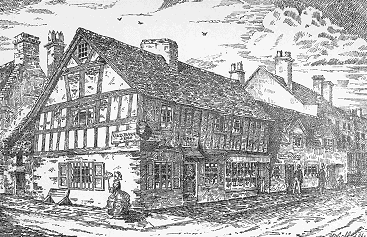
The Barrel Inn.
|
|
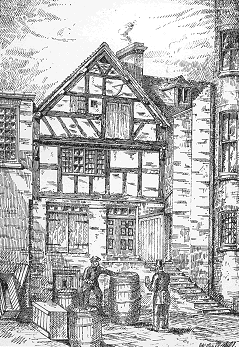
The Bird In Hand.
|
This old gable is a pleasing specimen of the
brick-timbered style of the 16th century. It originally formed a
portion of the "Bird in Hand" yard, the remainder of which was
pulled down about 1850.
The name is derived from a noted Inn, which together with
another of similar character, called the "Golden Ball", was much
frequented by market people, butchers, and other dealers, who in
that day pitched their stalls in the adjacent streets and Market
Place as Queen Square was then called.
The building is now used as a store or warehouse. The framing
is good and substantial, some of the beams are moulded, and have
carved trusses, and at one time formed a rather imposing pile of
a building. |
| The present Georgian red brick house was probably
built upon the site of a more ancient residence of the Deans, as we
find that Henry 1st gave a dwelling house and 40 acres of land in
Wolverhampton for the sustenance of 6 priests in the Church of St.
Mary, now St. Peter's.
In the reign of Edward IV, the deanery was attached to that at
Windsor, and so continued until the dissolution of the
Collegiate Establishment in 1846. |
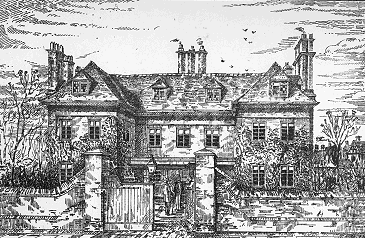
The Deanery.
|
| The present building was erected for and occupied
solely as a private residence, and now as a Conservative Club. |
|
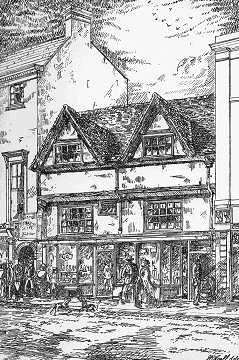
Dudley Street.
|
There are still remaining on opposite sides near to
Queen Street some old plastered and gabled houses of good character,
two sketches of which are given.
They have been in some respects modernised by erecting shop
fronts, but show the general style of buildings which doubtless
at one time formed the greater portion of this street, as the
"Peacock" and some adjacent premises which have of late years
been swept away, served to show.
In the interior some good oak wall panelling still exists. |
|
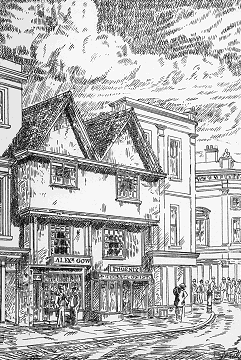
Dudley Street.
|
|
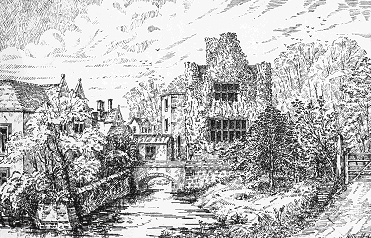
Dunstall Hall.
|
Dunstall was anciently a member of the King's Manor
called Stow Heath, and was the seat of the Wightwicks, who purchased
it in the 15th year of Charles II.
Dunstall is now the property of A. Staveley Hill, Esq., Q.C.,
M.P., and formerly belonged to Alexander Hordern, Esq., (who
also possessed Oxley). The house is surrounded by a moat and the
gate house dates from the 16th century. |
 |
|
 |
Return to
the art gallery |
|
Proceed to
the next page |
|